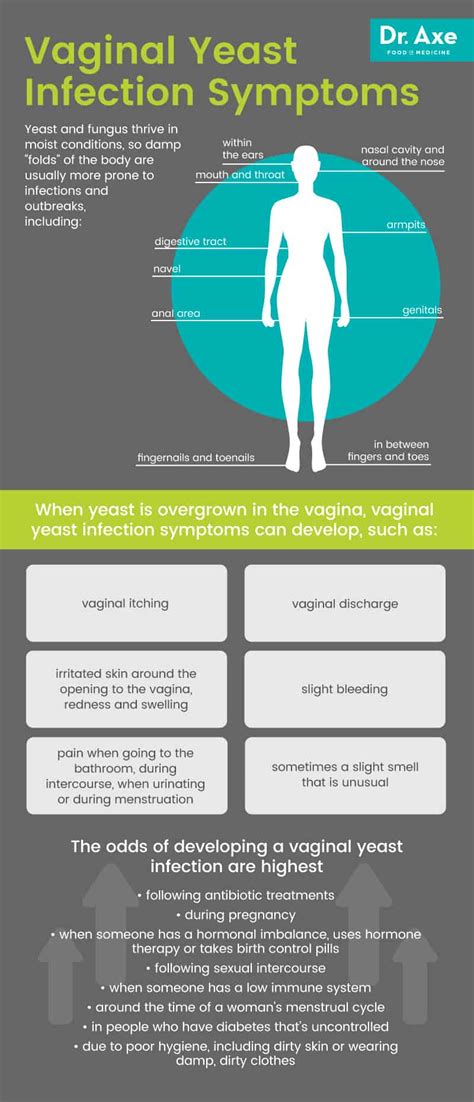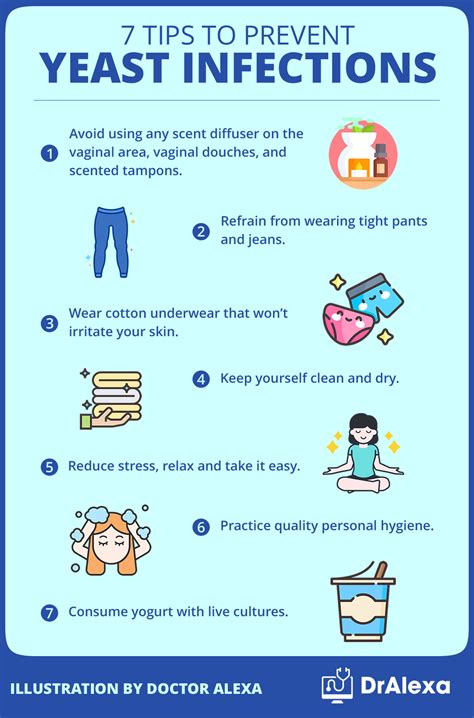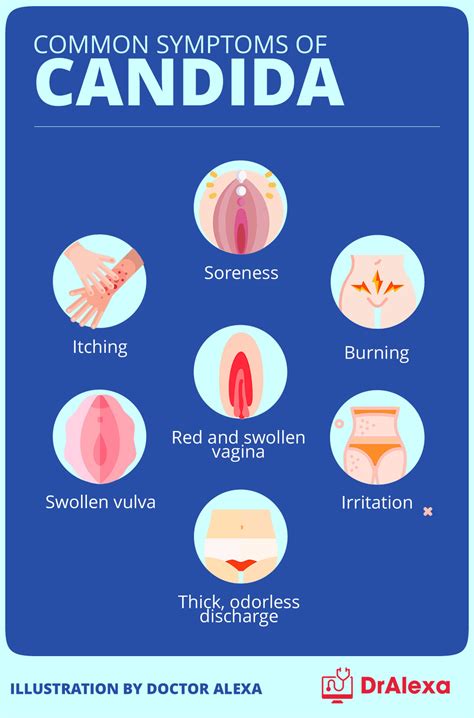Intro
Yeast infections are a common health issue that affects millions of people worldwide, causing a range of uncomfortable symptoms. Candida, a type of fungus, is the primary culprit behind yeast infections, and it can manifest in various parts of the body, including the skin, mouth, vagina, and intestines. Understanding the symptoms of yeast infections is crucial for prompt diagnosis and effective treatment. In this article, we will delve into the world of yeast infections, exploring their causes, symptoms, and treatment options.
Yeast infections can be debilitating, affecting a person's quality of life and overall well-being. The symptoms of yeast infections can vary depending on the location and severity of the infection. For instance, vaginal yeast infections can cause itching, burning, and redness in the affected area, while oral thrush can lead to white patches on the tongue and inside the mouth. Skin yeast infections, on the other hand, can result in rashes, itching, and flaky skin. Recognizing the symptoms of yeast infections is essential for seeking medical attention and preventing complications.
The importance of understanding yeast infection symptoms cannot be overstated. Yeast infections can be a sign of an underlying health issue, such as a weakened immune system or an imbalance of gut bacteria. If left untreated, yeast infections can lead to more severe health problems, including chronic inflammation, digestive issues, and even mental health concerns. By being aware of the symptoms of yeast infections, individuals can take proactive steps to prevent and manage these infections, promoting overall health and well-being.
Types of Yeast Infections

Yeast infections can manifest in different parts of the body, each with unique symptoms and characteristics. The most common types of yeast infections include vaginal yeast infections, oral thrush, skin yeast infections, and intestinal yeast infections. Vaginal yeast infections, also known as vulvovaginal candidiasis, affect the vagina and vulva, causing itching, burning, and redness. Oral thrush, on the other hand, affects the mouth, causing white patches on the tongue and inside the mouth. Skin yeast infections can occur on various parts of the body, including the arms, legs, and torso, resulting in rashes, itching, and flaky skin. Intestinal yeast infections, also known as candida overgrowth, can lead to digestive issues, such as bloating, gas, and diarrhea.
Causes of Yeast Infections
Yeast infections are caused by an overgrowth of Candida, a type of fungus that is naturally present in the body. Candida can overgrow due to various factors, including antibiotic use, hormonal changes, and a weakened immune system. Antibiotics can disrupt the balance of gut bacteria, allowing Candida to overgrow and cause an infection. Hormonal changes, such as those experienced during pregnancy or menopause, can also contribute to yeast infections. A weakened immune system, whether due to illness, stress, or poor nutrition, can make it difficult for the body to fight off Candida, leading to an infection.Symptoms of Yeast Infections

The symptoms of yeast infections can vary depending on the location and severity of the infection. Common symptoms of yeast infections include:
- Itching and burning in the affected area
- Redness and inflammation
- White patches or discharge
- Rashes or lesions
- Flaky skin or skin peeling
- Digestive issues, such as bloating, gas, and diarrhea
- Fatigue and weakness
- Mood changes, such as anxiety or depression
Treatment Options for Yeast Infections
Treatment for yeast infections depends on the severity and location of the infection. Mild yeast infections can be treated with over-the-counter antifungal medications, such as creams, ointments, or suppositories. More severe infections may require prescription medication, such as fluconazole or itraconazole. In addition to medication, lifestyle changes can help prevent and manage yeast infections. These include: * Practicing good hygiene, such as washing the affected area with soap and water * Wearing loose, breathable clothing * Avoiding tight-fitting clothing and synthetic fabrics * Eating a balanced diet rich in fruits, vegetables, and whole grains * Avoiding sugary and processed foods * Managing stress through techniques such as meditation or yogaPrevention of Yeast Infections

Preventing yeast infections requires a combination of lifestyle changes and good hygiene practices. Some ways to prevent yeast infections include:
- Practicing good hygiene, such as washing the affected area with soap and water
- Wearing loose, breathable clothing
- Avoiding tight-fitting clothing and synthetic fabrics
- Eating a balanced diet rich in fruits, vegetables, and whole grains
- Avoiding sugary and processed foods
- Managing stress through techniques such as meditation or yoga
- Avoiding antibiotics unless absolutely necessary
- Getting enough sleep and exercising regularly
Complications of Yeast Infections
If left untreated, yeast infections can lead to more severe health problems, including chronic inflammation, digestive issues, and even mental health concerns. Chronic yeast infections can also increase the risk of developing other health conditions, such as diabetes, arthritis, and autoimmune disorders. In rare cases, yeast infections can spread to other parts of the body, such as the bloodstream or internal organs, leading to life-threatening complications.Diagnosis of Yeast Infections

Diagnosing yeast infections typically involves a physical examination, medical history, and laboratory tests. A healthcare provider may perform a pelvic exam to check for signs of infection, such as redness, swelling, or discharge. A sample of tissue or discharge may be sent to a laboratory for analysis to confirm the presence of Candida. In some cases, a healthcare provider may also order imaging tests, such as a CT scan or MRI, to rule out other conditions.
Treatment of Recurring Yeast Infections
Recurring yeast infections can be challenging to treat and may require a combination of medication and lifestyle changes. A healthcare provider may prescribe a longer course of antifungal medication or recommend a maintenance therapy to prevent future infections. In addition to medication, lifestyle changes, such as practicing good hygiene, eating a balanced diet, and managing stress, can help prevent and manage recurring yeast infections.Yeast Infections and Pregnancy

Yeast infections during pregnancy can be a concern, as they can increase the risk of complications, such as preterm labor and low birth weight. Pregnant women are more susceptible to yeast infections due to hormonal changes and a weakened immune system. If a pregnant woman experiences symptoms of a yeast infection, she should consult her healthcare provider for proper diagnosis and treatment.
Yeast Infections and Menopause
Yeast infections during menopause can also be a concern, as hormonal changes can disrupt the balance of vaginal flora, leading to an overgrowth of Candida. Menopausal women may experience more frequent or severe yeast infections due to decreased estrogen levels, which can thin the vaginal lining and reduce its natural protective barriers. If a menopausal woman experiences symptoms of a yeast infection, she should consult her healthcare provider for proper diagnosis and treatment.Yeast Infections and Mental Health

Yeast infections can have a significant impact on mental health, particularly if left untreated or recurring. The symptoms of yeast infections, such as itching, burning, and fatigue, can be debilitating and affect a person's quality of life. Additionally, the emotional distress and anxiety associated with yeast infections can exacerbate underlying mental health conditions, such as depression or anxiety disorders. If a person experiences symptoms of a yeast infection, they should consult their healthcare provider for proper diagnosis and treatment, as well as seek support from a mental health professional if needed.
Conclusion and Final Thoughts
In conclusion, yeast infections are a common health issue that can have a significant impact on a person's quality of life. Understanding the symptoms, causes, and treatment options for yeast infections is essential for prompt diagnosis and effective management. By practicing good hygiene, eating a balanced diet, and managing stress, individuals can reduce their risk of developing yeast infections. If symptoms persist or recur, it is essential to consult a healthcare provider for proper diagnosis and treatment. By taking proactive steps to prevent and manage yeast infections, individuals can promote overall health and well-being.What are the common symptoms of yeast infections?
+Common symptoms of yeast infections include itching, burning, redness, and discharge in the affected area.
How can I prevent yeast infections?
+Preventing yeast infections requires a combination of lifestyle changes and good hygiene practices, such as practicing good hygiene, eating a balanced diet, and managing stress.
Can yeast infections be treated at home?
+Mild yeast infections can be treated with over-the-counter antifungal medications, but more severe infections may require prescription medication and medical attention.
We hope this article has provided you with a comprehensive understanding of yeast infections, their symptoms, causes, and treatment options. If you have any further questions or concerns, please do not hesitate to reach out to a healthcare professional. Share this article with friends and family to help raise awareness about yeast infections and promote overall health and well-being.
